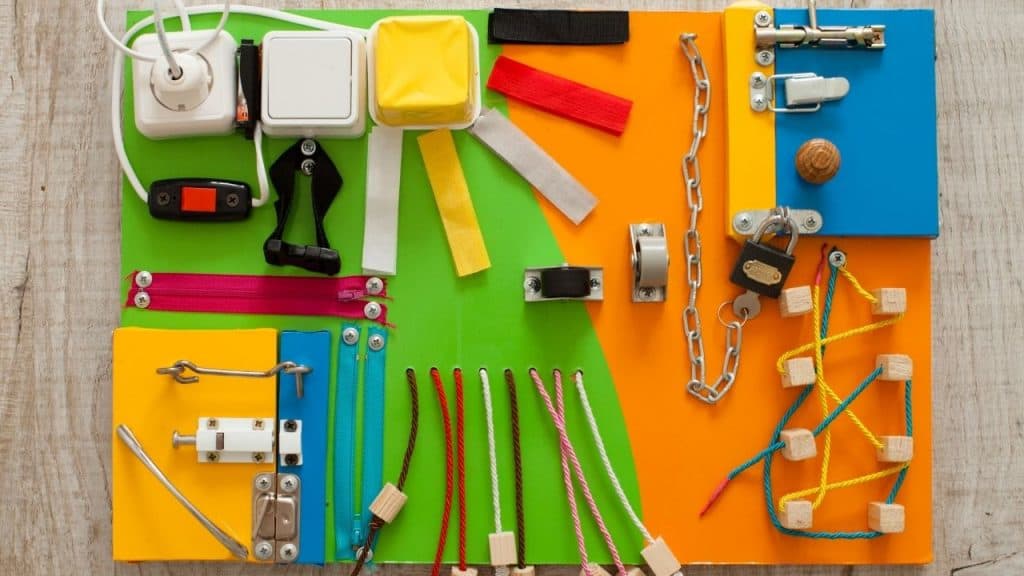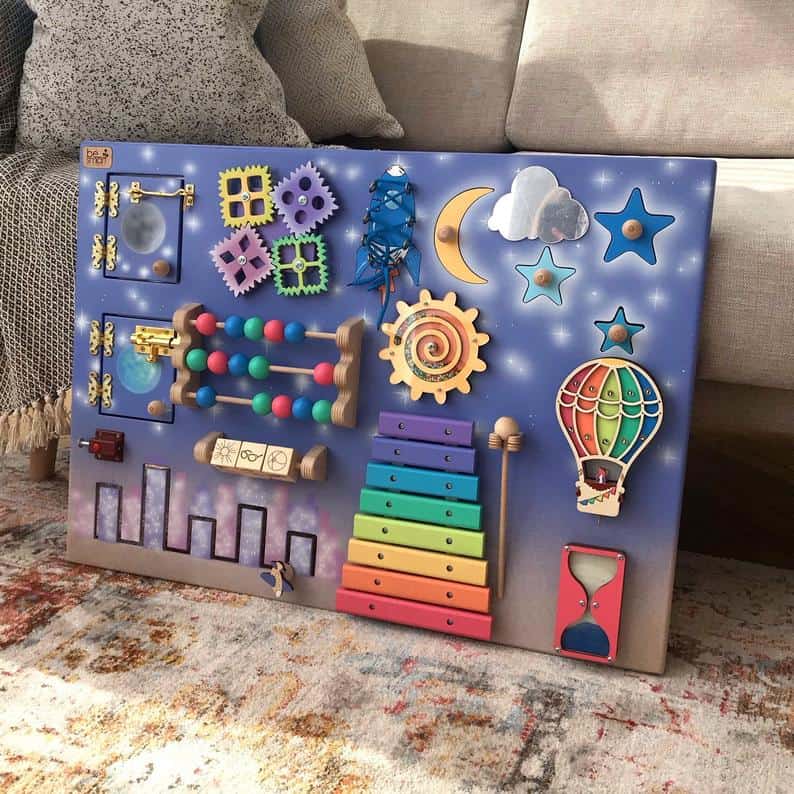Over the past decade or so, there has been an increased interest in Montessori teaching as well as the benefits of STEM learning for children of all ages. STEM learning, which is an acronym for Science, Technology, Engineering, and Mathematics, helps develop skills that are useful in STEM-related career fields.
Sensory boards for the wall are used to introduce children to the principles of STEM as well as sensory learning which is a part of the Montessori method. Sensory boards are great from babies and children of all ages. Wall sensory boards are used in daycares, school and homes all over the world.
Toys based on STEM are extremely beneficial for toddlers and preschoolers because they stimulate hand-eye coordination, motor skills, problem-solving and practical thinking, as well as creativity.

Sensory activities that revolve around STEM concepts can come in the form of a sensory wall that engages multiple facets of learning and development and can keep a toddler entertained while they explore.
What is a sensory wall?
A sensory wall, sometimes also called a busy board or Montessori board, is a panel that can be either free-standing or wall-mounted, is a panel that holds a variety of objects that can be manipulated by a toddler.
Objects often included on a sensory wall include latches, gears, switches, and bells, as well as a variety of materials that provide different tactile experiences like sponges or sandpaper, different types of fabrics, ribbons, or even flappable sequins.
What’s the purpose of sensory boards
Sensory walls move exploratory play from the floor to the wall and are placed at a height that allows a toddler to play independently and safely while standing or sitting. Children interact with a wide range of activities that stimulate four of the five senses (sight, sound, smell, and touch).
Many sensory boards also boast items that rely on cause-effect relationships, like pressing a battery-operated disc light to turn it on or off.

Such sensory play is crucial to mental and motor skill development in children and leads to the ability to handle more complicated learning tasks as a child grows.
What are the benefits of sensory boards for the wall
Sensory boards hold many developmental benefits for toddlers, including:
- Stronger nerve connections in the brain
- Hand-eye coordination and fine motor skill development
- Improved memory through repetition
- Language acquisition through the learning of new words for actions, sounds, or textures
- Problem-solving skills, critical thinking, and scientific thinking
An additional benefit exists when sensory boards are provided to children with anxiety, as the tactile experiences and eventual predictability of the board can help with relaxation.
Children with special needs can also engage in activities on the sensory board to target fine motor development or calming activities.
The Best Sensory Walls for Toddlers and Kids
Best Sensory Wall for Multiple Children – LEARNING ADVANTAGE Crocodile Activity Wall Panels
Features:
- Five panels provide space for more than one child to play.
- 11 different activities engage children in movement, sound, and color.
- Easy to assemble and mount to the wall with included hardware.
- Bright, engaging features and activities are just right for children ages 18 months and up.
Why We Love It
This large sensory wall provides just over six feet of options for sensory play. While the product is geared a bit more toward a daycare or preschool setting, parents with multiple children in the toddler age range will like the fact that there is plenty of room for more than one child to play at a time. Activities include bead mazes, gears, and a xylophone, all of which help promote fine motor skills and hand-eye coordination.
Best Value – SmartWoodenToys Toddler Busy Board
Features:
- 14 different toys and activities to engage multi-sensory play.
- More compact size allows for placement in a variety of spaces.
- Activities are appropriate for children as young as 10 months old up through 4 years old.
- Natural birch hardwood construction and decorated with child-safe water-based acrylic paints.
- Designed to be mounted on the wall.
Why We Love It
The handmade nature of this busy board means no two boards are the same and buyers know the product is made with care and quality. The beautiful color scheme is pleasing to adults and children, and the board boasts some unique items like square gears, lacing, and two different locks on the picture panels. The busy board can also be personalized to make it a special gift for any child.
Large Sensory Wall for Preschools and Playrooms – BumbleBeeSmart Activity Wall Board
Features:
- Large size and variety of sensory play options are a good choice for settings with multiple children.
- Five panels can be customized with different colors, toys, and activities.
- Easy to assemble and mount on a wall.
- Durable materials, like plywood, textiles, and metal accessories hold up to high usage.
Why We Love It
Another great option that fits well in both a preschool setting or a home playroom, this handmade activity wall has over twenty different components to engage multiple motor skills and sensory experiences. At almost six feet in length, up to five children can easily play side-by-side with plenty of room to explore and play. Some activities are even appropriate for babies as young as 8 months old with support from a caregiver.
Best Activity Center for Younger Toddlers – LEARNING ADVANTAGE Airplane Activity Wall Panels
Features:
- Five simple panels designed to form an airplane shape that entices children to play.
- Six activities promote experimentation while developing hand-eye coordination.
- Fixing holes and hardware included to allow the panels to be wall mounted.
- Great for children ages 18 months and up.
Why We Love It
The simple design of this activity center is particularly well-suited for children between the ages of 18 months and 3 years old. Included elements promote hand-eye coordination, experimentation, and sensory play without presenting too many options at once. At 70 inches in length, this board allows for more than one child to play side-by-side.
Best Sensory Wall Board for Small Spaces – LEARNING ADVANTAGE Horse Activity Wall Panel
Features:
- Child-friendly horse-shaped panel holds a wire bead maze and a four-cog gear system.
- Easy to mount on the wall with included hardware and pre-drilled fixing holes.
- Smaller size is perfect for homes where space is limited.
- Desigve It: This compact sensory board fits easily into any available space, from the corner of the playroom to the back of a bedroom door. The panel and its components are made of wood, except for the wire on the bead maze. The bead maze, too, has a launch lever that allows your child to experiment with force and cause-effect relationships. As a bonus, the lower price makes this a good option for families on a budget looking to invest in a sensory board.
- ned for children ages 18 months and up.
Why We Love It
This compact sensory board fits easily into any available space, from the corner of the playroom to the back of a bedroom door. The panel and its components are made of wood, except for the wire on the bead maze. The bead maze, too, has a launch lever that allows your child to experiment with force and cause-effect relationships. As a bonus, the lower price makes this a good option for families on a budget looking to invest in a sensory board.
Pegboard Sensory Board- LiL HOUSE Kids Activity Board
Features:
- Moveable pegs and accessories allow for flexibility in sensory play.
- Clock face, numerals, and mathematic signs practice arithmetic and math skills.
- Chalk board feature provides a space to practice letter and number formation or just creative drawing.
- Birch plywood construction.
- Can be hung on the wall or used on a table or the floor.
Why We Love It
A unique take on sensory boards, this pegboard sensory board is extremely customizable for whatever your child wishes to play. The pegs can be arranged to hang numeral or equation tags, or just to form different shapes and designs. The inclusion of a chalkboard promotes additional open-play and learning options, and older preschoolers who are learning the basics of writing and drawing will enjoy the space to practice those skills.
What age is a sensory board for
Sensory boards can be ideal for children of all ages, even for older preschoolers who learn best through tactile and kinesthetic activities. Depending on the style and the activities included, sensory boards work best for children ages 12 months to 4 or 5 years of age.
Do toddlers like sensory boards
The quick answer is a resounding: yes!
Sensory boards allow toddlers to explore new textures and objects that are easily accessible in one spot. Toddlers are curious about the world around them, and busy boards provide a safe way for them to touch, see, and hear what happens when they play with different objects and materials.
Whether a commercially made busy board or one you construct yourself with common household items, even young toddlers will be engaged and focused on playing with a sensory board.
How to Make Your Own Sensory Wall
If you think you would like to try your hand at making your own sensory wall, such a project is quite simple. The most time-consuming part is deciding what elements to include that will best engage your child.
First, determine how large of a sensory board you want and purchase a piece of ¾-inch thick plywood cut to your desired dimensions. Many home improvement stores will cut the plywood for your right on site, or you can do it yourself at home if you have the tools and know-how. Sand the surfaces and edges to ensure your little one won’t get splinters, then paint and seal the board.
You can look around your house for items to attach to your sensory board, or again take a trip to the home improvement store to gather materials. Good options include locks and latches, switches or buttons, ribbons and feathers, sponges, or small pillows or blocks wrapped in pieces of fabric. Carpet samples are a great textural option as well.
Use hot glue or wood glue to attach flat objects to the board, while hardware elements will likely require nails or screws to secure to the surface of your sensory wall. If you’re particularly handy, you can also cut small flaps of particle board or wood and attach to the board with hinges to hide pictures of family members, animals, or everyday objects.
See below to watch a video showing how to make a simple and easy sensory board
If you’re still interested in making your own sensory board, check out this step-by-step tutorial on how to construct a busy board.
Vikki is the creator of Totsgo and the mother of two children. She is a passionate mother who enjoys assisting other parents.






